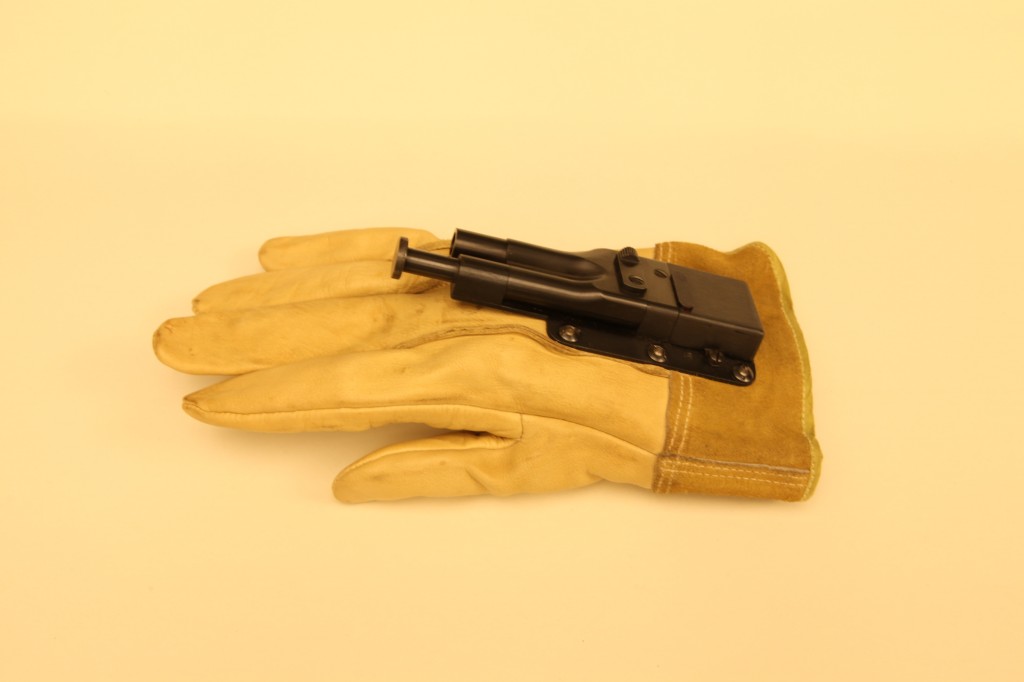One of the most unusual weapons of the Second World War was the Glove or Fist Gun. During the war in the Pacific, the Imperial Japanese hung onto every bit of rock and coral that they could, long after they were cut off from supplies. This was a major concern for rear area units like aircrew, seabees, and administrative personnel. To try and combat this threat, a captain in the US Navy named Stanley Haight designed a simple, close-range personal defense weapon that could be kept close at hand.
The example in the National World War Two Museum
The weapon was attached to the back of a work glove and was used by punching the target, which would depress the trigger and fire the single round contained in the gun. Haight's design was produced in very limited numbers (perhaps as low as 52) by the Sedgley Company.
The Sedgley Company was founded in Philadelphia by inventor Reginald F. Sedgley around 1916. They produced the 'Hexall' brand of sockets, small 'bicycle guns', and used surplus Springfield and Krag rifle actions to make hunting rifles between the world wars. They bid on several small contracts for the Navy, including 12 gauge flare guns and the glove gun. Among other things, they made gas guns and a fountain pen pistol. Sedgley himself died at the age of 61 on March 30th, 1938. The company closed its doors in 1952.
The mechanism for the glove gun was fairly simple, consisting of a 2 7/8 inch smoothbore barrel and the trigger mechanism attached to what was essentially a leather gardening glove. The barrel section swiveled open to allow loading a single round of .38 S&W. A sliding bar was used as the safety to prevent negligent discharges. The gun was attached to the glove with six rivets. The barrel was unlocked by pressing a small button on the side of the weapon, as can be seen below.
The rivet holes can be clearly seen here, the vertical bar on the left is the safety
Little is known about how often the glove gun was actually used. It is known that the some of the Beach Jumpers, US Navy special psychological operations units, were issued glove guns. They were instructed to use them should their vessel be boarded by the enemy while their hands were raised as in surrender, concealing the firearm. When the enemy got close enough, then they were supposed to punch them in the head. The example in the National WWII Museum was issued to a member of the Beach Jumpers named Lawrence Hanna. He never used it, asking the reasonable question of 'What about the next guy to come on board?' Instead, he mailed it home, still in its original box. Later it was donated to the museum.
At least a few were issued to the Seabees as well, as apparently builder John Blocker used one to dispatch a Japanese soldier who climbed onto his road grader while with the 31st Naval Construction Battalion. There have also been persistent rumors that the Office of Strategic Services (OSS) used them as assassination weapons. But I haven't been able to find concrete sources for either of these events.
The glove gun is exempt from the National Firearms Act, as it is described as a 'Curio or Relic'. Several museums have examples, but buying one of your own might run you as high as $7,000.
Captain Haight was awarded the Silver Star for his work as a beachmaster during the invasion of Leyte in 1944 after the primary beachmaster was incapacitated. He retired from the Navy as a Rear Admiral, passed on in 1974, and is interred in Annapolis.
In the end, its best known for its appearance in the film Inglourious Basterds, where two characters use them to kill a pair of SS soldiers guarding Hitler.
Sources:
Guns.com article. http://www.guns.com/2012/07/09/sedgley-oss-glove-gun/
Obituary for R.F. Sedgley. http://query.nytimes.com/gst/abstract.html?res=9406E4D81738EE3ABC4850DFB5668383629EDE&legacy=true
Forgotten Weapons video at the National WWII Museum. https://www.youtube.com/watch?v=1hkmc0o8uVk
National WWII Museum article. http://www.nww2m.com/2011/09/weird-weapon-with-a-hollywood-connection/
Fist Gun patent, number 2,423,488. https://docs.google.com/viewer?url=patentimages.storage.googleapis.com/pdfs/US2423448.pdf


Comments
Post a Comment